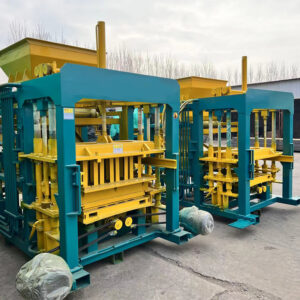
Image source :Aiweiblockmachine
Brick making machines have revolutionized the construction industry by streamlining the process of brick production. These machines have replaced traditional manual methods, allowing for greater efficiency, consistency, and output. Understanding the working mechanism of brick making machines is crucial for anyone involved in the construction industry or interested in the manufacturing process of this essential building material. In this article, we will delve into the intricate workings of brick making machines, exploring the various types, components, and processes involved in the production of high-quality bricks.
Types of Brick Making Machines:
Manual Brick Making Machines:
- Traditional method employing manual labor and simple tools.
- Suitable for small-scale production.
- Involves manually filling and compacting the brick molds.
- Requires physical effort and is time-consuming.
- Semi-Automatic Brick Making Machines:
- Combines manual labor with some automated processes.
- Requires human intervention for loading raw materials and unloading finished bricks.
- Involves a mechanical system for molding and compressing the bricks.
- Enhances productivity and reduces labor requirements.
- Fully Automatic Brick Making Machines:
- Highly automated machines capable of continuous operation.
- Integrates the entire process, from raw material input to finished brick output.
- Utilizes advanced technology, such as hydraulic systems and programmable controls.
- Maximizes productivity and minimizes human intervention
Components of Brick Making Machines:
- Raw Material Feeding System:
- Involves the introduction of raw materials into the machine.
- Typically consists of hoppers or conveyors for efficient material transfer.
- May include additional components for material storage and blending.
- Mixing System:
- Ensures thorough blending of raw materials, such as clay, cement, sand, and additives.
- Utilizes mixers or agitators to achieve a homogenous mixture.
- Water is added in precise proportions to achieve the desired consistency.
- Molding System:
- Shapes the mixture into bricks of specific dimensions.
- Employs molds or dies made from metal or other materials.
- In manual and semi-automatic machines, the operator manually fills the molds, while fully automatic machines employ mechanical systems for mold filling.
- Compression System:
- Applies pressure to the molded bricks to enhance their strength and density.
- Hydraulic or mechanical systems are commonly used for compression.
- Pressure is carefully regulated to prevent deformation or damage to the bricks.
- Drying and Curing System:
- Facilitates the removal of moisture from the newly formed bricks.
- Various methods can be employed, such as natural drying, kiln drying, or steam curing.
- Proper drying and curing are crucial for achieving optimal brick strength and durability.
Working Process of Brick Making Machines:
A
- Preparation and Mixing:
- Raw materials, including clay, sand, cement, and water, are collected and prepared.
- The materials are accurately measured and proportioned according to the desired brick composition.
- Mixing equipment, such as paddle mixers or pan mixers, blend the materials thoroughly to create a uniform mixture.
- Molding and Compression:
- The mixed material is transferred to the molding system.
- In manual and semi-automatic machines, the operator fills the molds with the mixture and compacts it using hand-operated levers or mechanical devices.
- Fully automatic machines utilize mechanical systems for precise mold filling and compression.
- The compressed bricks are then ejected from the molds, ready for the drying and curing process.
- Drying and Curing:
- The freshly molded bricks are subjected to a drying process to eliminate excess moisture.
- Natural drying involves placing the bricks in a well-ventilated area, protected from direct sunlight and rain.
- Alternatively, kiln drying or steam curing can be employed for faster and more controlled drying.
- The duration of drying and curing varies depending on the brick composition and environmental conditions.
- Quality Control and Packaging:
- Once the bricks are fully dried and cured, they undergo quality control inspections.
- Bricks that meet the desired specifications are stacked, packaged, and prepared for transport or storage.
- Quality control measures include checking for dimensional accuracy, strength, color consistency, and surface finish.
.
Conclusion:
Brick making machines have significantly improved the efficiency and consistency of brick production in the construction industry. Understanding the working mechanism of these machines is essential for manufacturers, builders, and anyone involved in the production and application of bricks. From the different types of brick making machines to the various components and processes involved, each step plays a crucial role in producing high-quality bricks. As technology continues to advance, brick making machines will continue to evolve, further enhancing productivity and sustainability in the construction sector.
